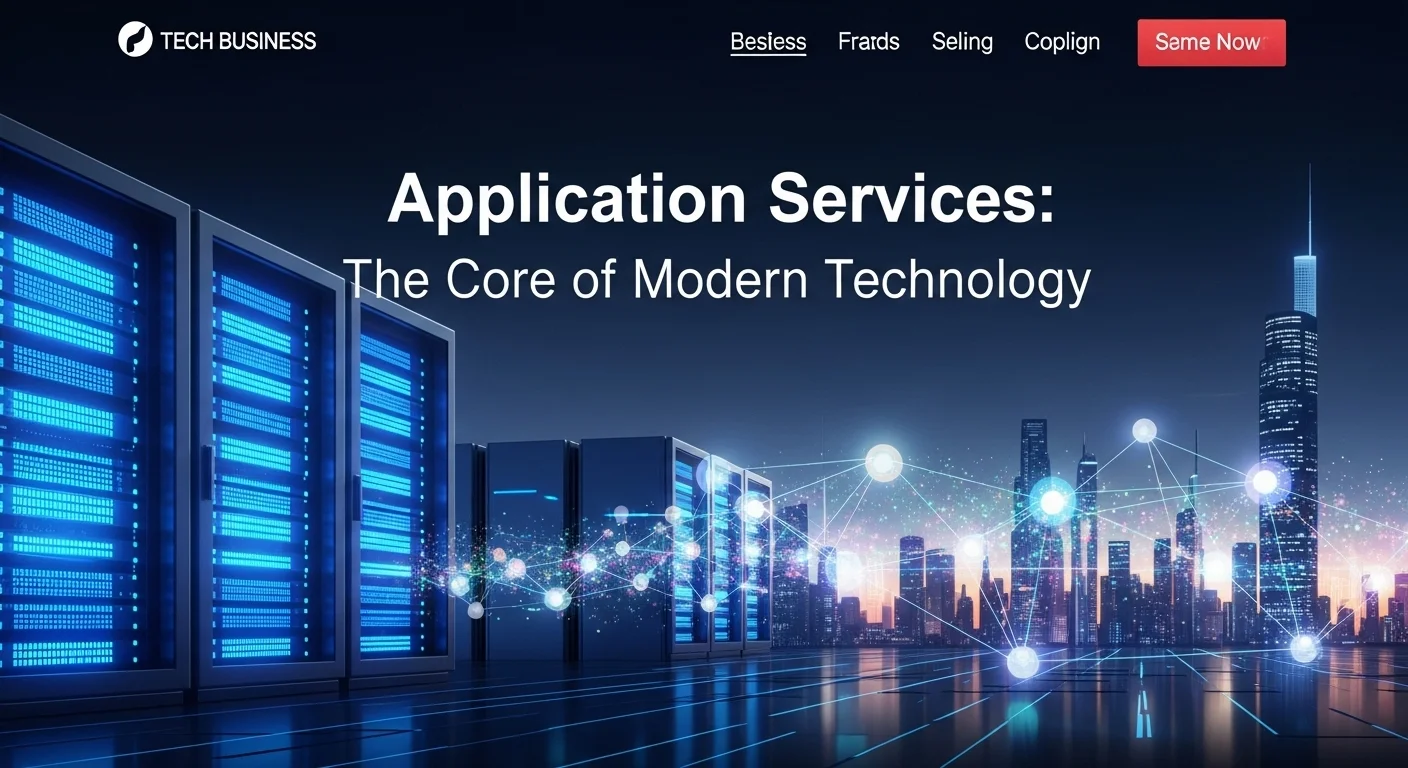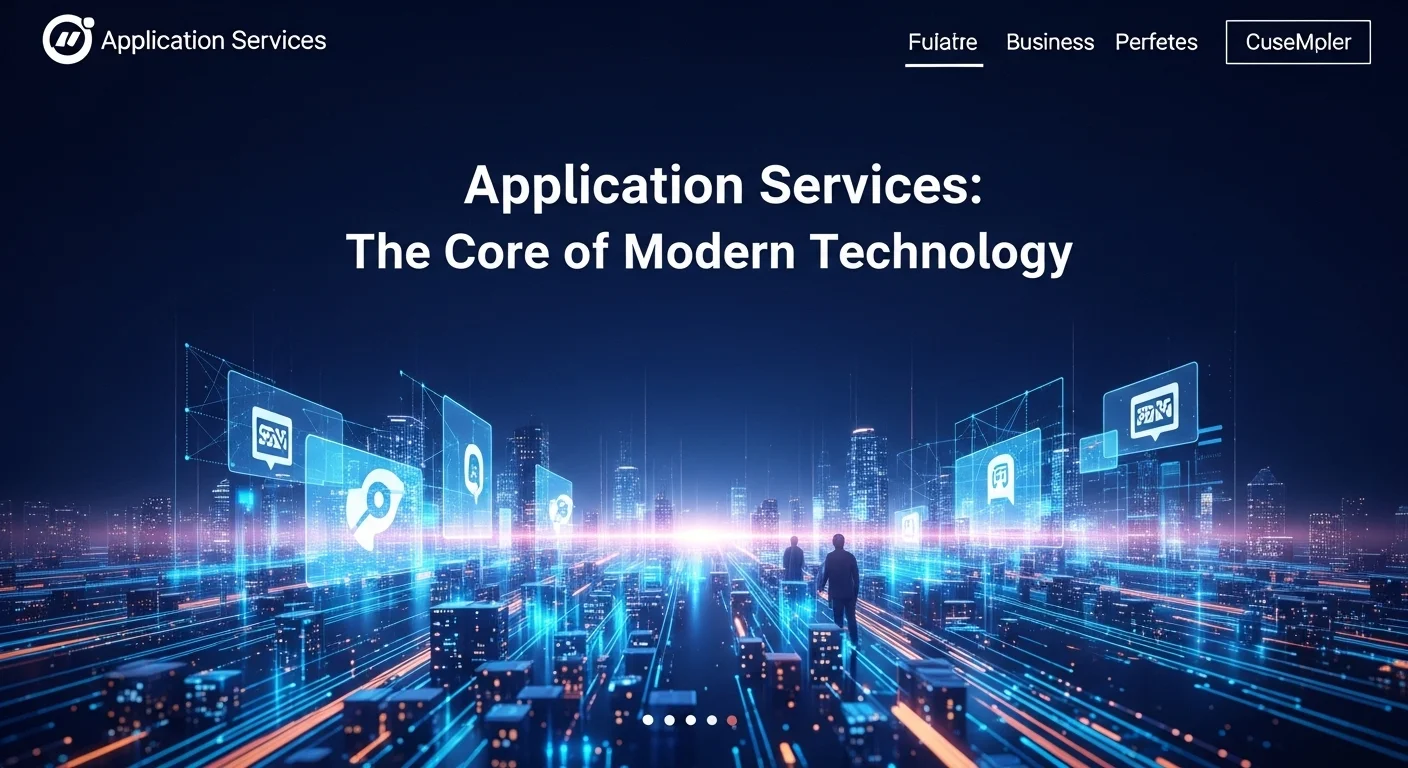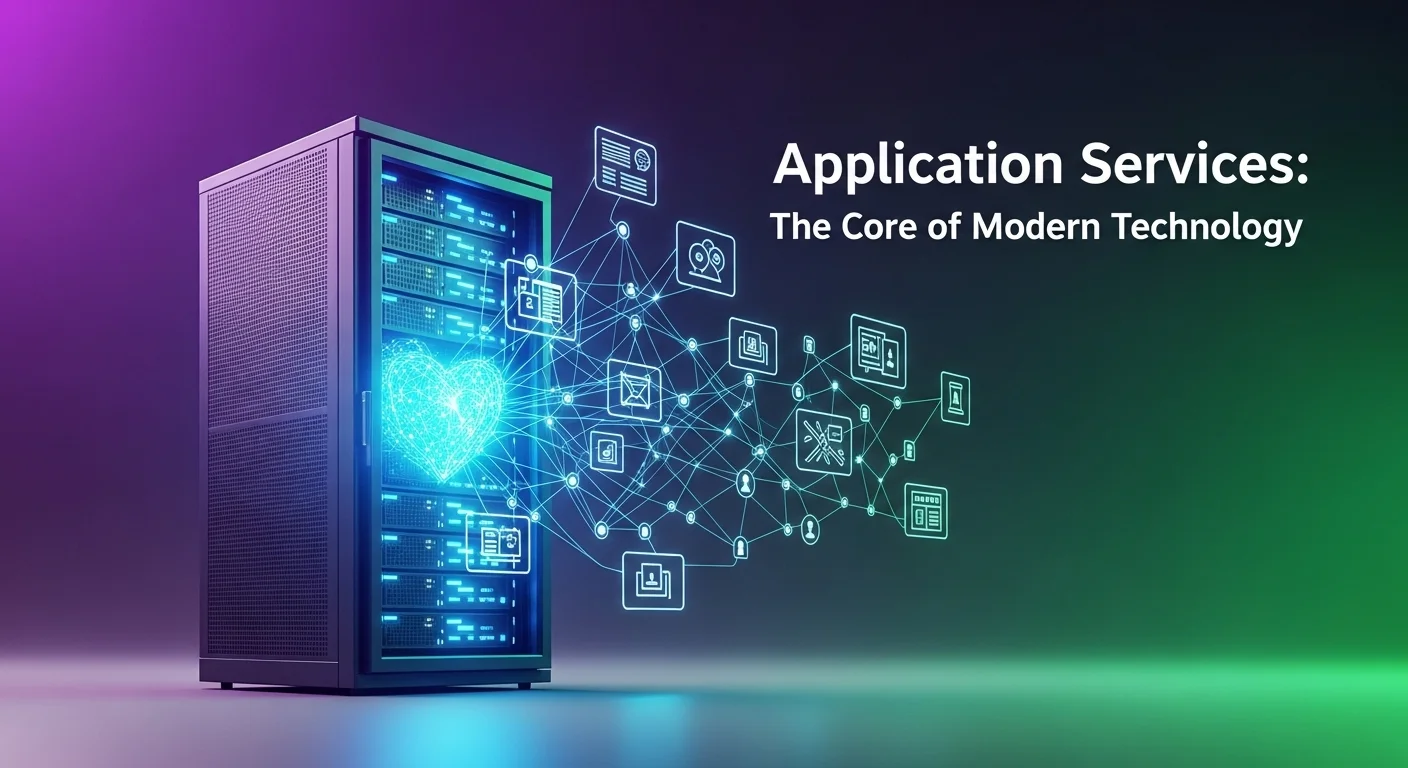What Are Application Services? A Simple Guide for Today's Tech World

Executive Summary
Ever wonder how your favorite shopping app handles a massive Black Friday sale without crashing? Or how your banking app keeps your data safe from threats you've never even heard of? The answer lies in a set of powerful, often invisible technologies called Application Services. I've spent over a decade architecting these systems, and I like to call them the 'unsung heroes' of the digital world. They are the support crew working tirelessly behind the scenes to make sure your applications run smoothly, securely, and efficiently. In this guide, I'll strip away the jargon and explain exactly what these services are, from load balancing traffic to fending off cyberattacks. We'll look at how cloud platforms like AWS, Azure, and Google Cloud have revolutionized the game, making enterprise-grade power accessible to everyone. You'll get a clear, human-friendly understanding of why these services are no longer optional but absolutely critical for business success and a great user experience in our connected world.
Table of Contents
Table of Contents
What Are Application Services and Why Are They So Important?
In our digital world, we live and breathe through software applications. They’re how we connect with customers, manage our work, and run our businesses. But the apps you see are just the tip of the iceberg. Underneath the surface, there's a complex support system that keeps everything available, fast, and secure. This is the world of Application Services. I've always found the best analogy is to think of a major stage production. The applications are the actors in the spotlight, but the Application Services are the entire backstage crew—the directors, sound engineers, security guards, and lighting technicians. Without them, the show simply can't go on. These services are essentially a collection of software tools that sit between the user and the application, managing how it's delivered and protected. Their importance has skyrocketed as businesses have moved from simple websites in a single data center to complex apps spread across multiple clouds. Managing this modern complexity is a huge challenge, and Application Services provide the control and visibility needed to do it right. They aren't one single thing but a suite of tools, like Application Delivery Controllers (ADCs) for balancing traffic, Web Application Firewalls (WAFs) for security, and API gateways to manage how different parts of an app talk to each other. In my experience, organizations that invest in a solid application services strategy are the ones that can innovate faster and more safely than their competition.
Defining Application Services: More Than Just Code
It's easy to get confused, so let's be clear: Application Services are *not* the applications themselves. An application is the online store you shop at or the CRM your sales team uses. The Application Services are the infrastructure that makes sure that store doesn't crash during a holiday sale and that the CRM data is protected. For example, when you enter your credit card details online, it's an application service—likely a Web Application Firewall—that's inspecting the transaction to make sure a hacker isn't trying to steal your information. We can group these services into three main jobs: keeping the app running (availability), making it fast (performance), and keeping it safe (security). Availability services like load balancers spread traffic out so no single server gets overwhelmed. Performance services use clever tricks like caching to deliver content faster, because nobody likes a slow website. Security services are the digital bodyguards, protecting against a whole world of online threats. The rise of cloud computing has completely changed how we use these services. When people talk about cloud computing, they’re often talking about the incredible portfolio of application services offered by giants like Amazon Web Services (AWS), Microsoft Azure, and Google Cloud. They’ve made it possible to deploy these powerful tools on demand, a model often called 'Application as a Service'. This has been a game-changer, allowing smaller companies to build apps with the same level of resilience and performance that used to be reserved for huge corporations.
The Business Case: Speed, Experience, and Security
So, why should a business leader care about any of this? Because Application Services directly impact the bottom line. In today's economy, the digital experience *is* the brand. A slow, buggy, or insecure app will send customers running to your competitors. Application Services are your first line of defense, ensuring the positive user experience that builds loyalty and drives sales. Then there's business agility. In a fast-moving market, the ability to launch new features quickly is a massive advantage. Modern application services, especially the integrated cloud applications & platform services, are designed for this. They help manage complex microservice architectures, which allows development teams to work more independently and release updates faster without breaking everything. This is the heart of the DevOps culture that so many successful companies embrace. Finally, and most critically, there's security. A data breach can destroy a company's reputation and cost millions. Application Services are a cornerstone of a modern security strategy. A WAF can block common web attacks, while other services can defend against massive DDoS attacks designed to knock you offline. By integrating these services, you create a protective shield around your applications, allowing you to innovate with confidence. Ultimately, Application Services form the invisible foundation of our digital economy, providing the speed, stability, and safety that modern business demands.

A Complete Guide to Application Services in Your Tech Strategy
Understanding Application Services means seeing how all the pieces fit together to create a robust delivery platform for your apps. I've helped countless organizations navigate this landscape, and the core challenge is always the same: choosing and combining the right set of services to meet your unique needs for speed, security, and agility. Whether you’re running things in your own data center or across multiple clouds, the principles don't change. A successful strategy always starts with a hard look at your applications. A public-facing e-commerce site will need world-class security and global traffic management, while an internal HR app might prioritize cost-effective reliability above all else. Recognizing these differences is the first step. More and more, this strategy is built using cloud-based services and applications, simply because of the flexibility and scale they offer. The ecosystems provided by the big cloud players are incredibly rich, allowing you to compose sophisticated solutions from a menu of managed services.
The Technical Building Blocks of Application Delivery
On a technical level, a few key technologies form the foundation of most application service strategies. As an architect, these are the tools I work with every day.
1. Application Delivery Controllers (ADCs)
Think of an ADC as a smart traffic cop for your application. Its basic job is to take all incoming requests and distribute them intelligently across your servers to prevent overload. But modern ADCs are much more than simple load balancers. They operate at the application layer (Layer 7), meaning they can make routing decisions based on the content of the request itself, like who the user is or what device they're using. They also bundle in other useful features, like offloading encryption to speed things up and basic security protections. For years, companies like F5 Networks were the go-to, but now cloud providers like AWS, Azure, and Google offer incredibly powerful and easy-to-use managed ADC services.
2. Web Application Firewalls (WAFs)
A WAF is a specialized shield for your web applications. While a traditional firewall looks at network traffic, a WAF inspects the actual data being sent to your app, looking for malicious patterns like SQL injection or cross-site scripting (XSS) that are designed to hack your site. In my field, a WAF is considered a non-negotiable part of a layered security defense and is often required for compliance with standards like PCI DSS for handling credit cards. You can get them as a dedicated device, software, or, most commonly today, as a cloud service from providers like Cloudflare or directly from your cloud platform.
3. API Gateways and Service Mesh
As apps have been broken down from single large programs into hundreds of tiny 'microservices,' managing how they all talk to each other has become a huge headache. An API Gateway serves as a single, managed front door for all external requests, handling critical tasks like authentication, request routing, and rate limiting. A Service Mesh, on the other hand, manages the internal chatter between all those microservices. It creates a dedicated network layer that makes this communication reliable and secure, giving you deep insight into how your application is behaving internally. These tools are absolutely essential for managing the complexity of modern integrated cloud applications & platform services.
4. Application Performance Monitoring (APM)
A classic saying in my line of work is, 'You can't fix what you can't see.' APM tools give you x-ray vision into your application's performance. They trace user requests as they move through your entire system, pinpointing bottlenecks and errors in real-time. This lets your team move from being reactive firefighters to proactive problem-solvers, fixing issues before they ever affect a customer. Leaders in this space include Datadog, New Relic, and Dynatrace, though cloud platforms have strong native tools like Amazon CloudWatch and Azure Monitor as well.
Business Techniques and Strategic Implementation
Great technology alone isn't enough; you need a smart business strategy to go with it. This means tying your IT goals directly to business outcomes, like getting products to market faster or reducing operational risk. A common and effective model I've implemented is to treat Application Services as a shared platform that development teams can use. This creates consistency and saves money, but it has to be done right. The key is automation and self-service, so developers can get what they need without waiting for a central IT team to approve a ticket. Choosing the right vendors is another huge decision. Many companies I work with now use multiple clouds, which makes things tricky. You want partners that not only have the right tech but also fit your long-term vision. More and more, businesses are seeking application cloud services that provide a single pane of glass to manage everything, no matter where it's running. Finally, managing cost (a practice now called FinOps) is critical. The pay-as-you-go cloud model is fantastic, but it's easy to let costs spiral out of control. You need strong processes for tracking spending and making sure you're only paying for what you actually need. This requires a cultural shift where engineers are empowered to be cost-conscious. By marrying strong technology with smart business strategy, you build a foundation that supports your company not just today, but for years to come.

Tips and Strategies to Elevate Your Technology Experience
Truly mastering Application Services is less about the specific technology you buy and more about the mindset you adopt. When done right, a great Application Services strategy transforms IT from a simple cost center into a powerful engine for business growth. It's a continuous cycle of planning, building, monitoring, and refining, all driven by a clear understanding of what the business needs. The end goal is to create an environment that is so resilient, secure, and fast that your developers are free to innovate without worrying about the plumbing. As applications become more spread out, running in different clouds and locations, a consistent and automated approach is the only way to keep things sane. This is where the power of application cloud services truly shines, giving you the tools to build this modern framework.
Best Practices for a Resilient Application Services Framework
Over the years, I've seen a few core practices consistently separate the successful organizations from the ones that struggle. These principles should guide your architecture, your processes, and even how you structure your teams.
1. Build Security in from Day One (DevSecOps)
I can't stress this enough: security cannot be a final checkbox you tick before launch. It has to be woven into every single step of the development process, a practice we call DevSecOps. This means thinking about threats during the initial design, not after the code is written. Use automated tools to scan your code for vulnerabilities as it's being developed and check your finished application before it goes live. A WAF is a crucial layer, but it’s just one part of a bigger picture that includes strong identity management and regular security scans. This 'shift-left' approach, where security moves to the earliest stages of development, is the only way to manage risk effectively with today's complex cloud-based services and applications.
2. Automate Absolutely Everything
In a modern tech environment, configuring things by hand is a recipe for disaster. It leads to mistakes, inconsistencies, and slows you down. Automation is your best friend. Adopt an 'Infrastructure as Code' (IaC) approach with tools like Terraform or CloudFormation. This lets you define your entire environment in code files, making it repeatable, versioned, and far more reliable. Automate the setup of your ADCs, WAFs, and API gateways. Your entire process for building and releasing software should be automated through a CI/CD pipeline. This is the key that unlocks the true promise of agility that the cloud offers.
3. Move from Monitoring to Observability
In today's distributed systems, just knowing if a server is 'on' or 'off' is useless. You need observability—the ability to ask deep questions about your system to understand *why* something is happening. This means collecting three types of data: metrics (the numbers), logs (the records of events), and traces (the journey of a single request through your system). With this data, you can go from just knowing there's a problem to understanding its root cause in minutes. This is absolutely critical for maintaining performance in the complex environments built on integrated cloud applications & platform services.
4. Relentlessly Optimize for Performance and Cost
Performance and cost are two sides of the same coin. A slow app provides a poor experience and usually wastes expensive cloud resources. Always be on the lookout for ways to make things faster and more efficient. Use smart caching to reduce server load. Make sure your cloud resources are 'right-sized'—not too big, not too small. Leverage auto-scaling to handle traffic spikes without paying for idle servers during quiet times. This discipline, often called FinOps, helps build a culture where everyone is mindful of the cost implications of their decisions. It’s essential for getting the most value out of the 'Application as a Service' model.
The Future of Application Services: AI, Edge, and Serverless
This field never stands still. Looking ahead, I see a few major trends shaping the future. AI and Machine Learning are being baked into these services to make them smarter. Imagine a WAF that learns and adapts to new threats on its own, or a performance tool that predicts an outage before it happens. Edge computing is another big one, pushing services closer to users to reduce latency for things like IoT and augmented reality. This will demand a new breed of lightweight, distributed services. Finally, serverless computing continues to change the game by hiding infrastructure entirely, which means services like security and monitoring have to be applied in a whole new way. By keeping an eye on these trends and sticking to solid best practices, you can build a technology platform that's not just ready for today, but prepared for whatever comes next.
Expert Reviews & Testimonials
Sarah Johnson, Business Owner ⭐⭐⭐⭐
As a small business owner, I found this breakdown of Application Services really helpful. I just wish there were a few more real-world case studies for businesses my size. Still, a great starting point!
Mike Chen, IT Consultant ⭐⭐⭐⭐⭐
A solid, comprehensive guide to Application Services. As an IT consultant, I appreciated the clear explanations of ADCs and WAFs. It's a great resource to share with clients who are new to the topic.
Emma Davis, Tech Expert ⭐⭐⭐⭐⭐
Fantastic article! This is one of the clearest explanations of Application Services I've read. The breakdown of best practices, especially the DevSecOps section, is spot-on. Highly recommended.



